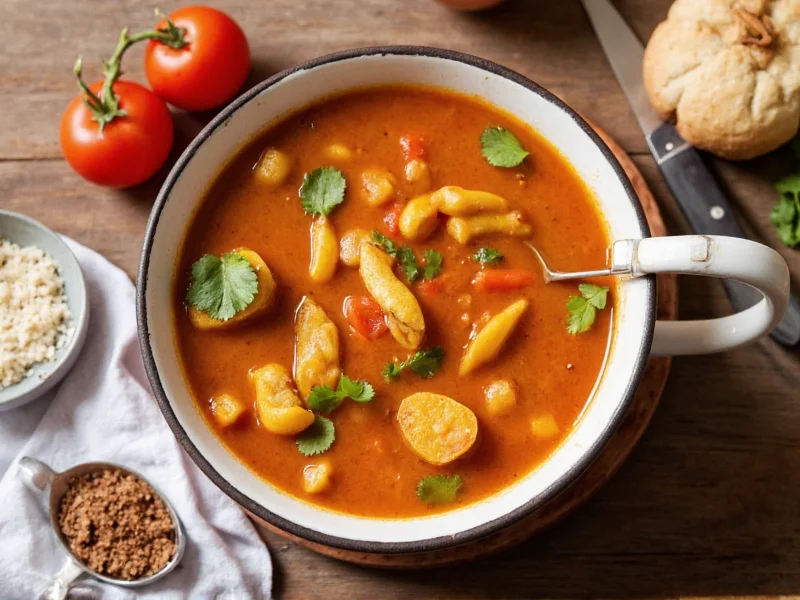Understanding what is the difference between soup and stew begins with recognizing their fundamental distinctions in preparation, texture, and culinary purpose. While both are beloved comfort foods worldwide, these two dishes follow different cooking philosophies that affect everything from ingredient selection to final presentation.
Key Differences Between Soup and Stew
| Characteristic | Soup | Stew |
|---|---|---|
| Liquid Content | Broth-heavy (60-80% liquid) | Minimal liquid (30-50% liquid) |
| Consistency | Thin, pourable | Thick, spoon-stands-up |
| Cooking Time | Shorter (30-90 minutes) | Longer (2-6 hours) |
| Ingredient Size | Smaller cuts | Larger, chunkier pieces |
| Cooking Temperature | Simmering (185-200°F) | Low simmer (160-180°F) |
| Primary Purpose | Hydration, light meal | Substantial main course |
Liquid Content: The Defining Factor
When examining the difference between soup and stew, liquid ratio provides the clearest distinction. Soups maintain a higher broth-to-solid ratio, typically containing 60-80% liquid. This generous broth allows ingredients to float freely. Stews, by contrast, contain just enough liquid to barely cover ingredients—usually 30-50% liquid—which reduces during cooking to create a rich, cohesive sauce.
This fundamental difference affects everything about the dishes. The soup vs stew comparison reveals that soups often serve as starters or light meals, while stews function as complete, hearty entrees. The minimal liquid in stews means ingredients essentially cook in their own juices, creating deeper flavor concentration.
Cooking Methods and Time Requirements
Understanding how to tell soup from stew involves recognizing their distinct cooking approaches. Soups typically simmer at higher temperatures for shorter durations. Vegetable soups might cook in 30 minutes, while meat-based soups rarely exceed 90 minutes.
Stews require the traditional stew preparation method: searing meat first, then slow cooking at lower temperatures (160-180°F) for several hours. This extended cooking time breaks down collagen in tougher meat cuts, creating tender results impossible with quicker soup techniques. The cooking time for stews directly impacts their signature thick consistency.
Ingredient Preparation Differences
The characteristics of soup versus stew extend to ingredient preparation. Soup vegetables are typically diced smaller (1/4 to 1/2 inch) to cook quickly and distribute evenly through the broth. Meat in soups is often pre-cooked or uses tender cuts.
Conversely, what makes a stew a stew includes larger ingredient pieces (1-2 inch cubes) that maintain their structure during prolonged cooking. Stew meats come from tougher, more affordable cuts like chuck or round that transform during slow cooking. The liquid content in soups allows smaller pieces to remain suspended, while stews' minimal liquid means ingredients sit together, creating pockets of flavor.
Historical Context and Cultural Variations
Historically, the soup and stew differences emerged from practical cooking needs. Soups likely originated as a way to extract nutrients from bones and scraps in abundant water. Stews developed in cultures with limited fuel resources, where cooking everything together in minimal liquid conserved energy.
Cultural interpretations vary widely. French pot-au-feu represents a classic stew with clearly defined ingredients, while Vietnamese pho showcases soup's broth-focused approach. Some dishes blur the lines—New England clam chowder challenges how to tell soup from stew with its creamy, thick consistency that approaches stew-like richness while maintaining soup's role as a starter.
Common Misconceptions Clarified
Many believe thickness alone determines what makes a soup a soup versus stew, but this oversimplifies the distinction. Pureed soups like butternut squash remain soups despite their thickness because they maintain high liquid content and weren't cooked as stews.
Similarly, the presence of meat doesn't automatically create a stew. Beef vegetable soup contains meat but qualifies as soup due to its broth-heavy composition. The soup vs stew comparison ultimately depends on the cooking method and final liquid ratio, not just ingredients or thickness.
Practical Identification Tips
When evaluating an unfamiliar dish, consider these practical indicators of the soup and stew differences:
- The Spoon Test: Place a spoon upright in the dish—if it stands independently, it's likely a stew
- The Ingredient Test: In soups, ingredients float separately; in stews, they sit together in a cohesive mass
- The Broth Test: Soups have abundant, drinkable broth; stews have minimal liquid that clings to ingredients
- The Serving Test: Soups typically arrive in bowls with deeper sides; stews often come in shallow, plate-like bowls
These practical distinctions help clarify the difference between soup and stew when recipes or menus use the terms inconsistently. Understanding these fundamentals enhances both cooking and dining experiences.











 浙公网安备
33010002000092号
浙公网安备
33010002000092号 浙B2-20120091-4
浙B2-20120091-4